Abstract
Handprints observed in Oklahoma and interpreted as indicative of sasquatch activity are depicted. Comparisons with casts of purported sasquatch hand impressions made in the Pacific Northwest are presented and briefly discussed.
Introduction
Footprint casts represent by far the most prevalent form of evidence collected during the last six decades in support of the existence of an undocumented American ape. As discussed by primate anatomy experts Grover Krantz, Jeff Meldrum, and others, many of these casts display coherent and consistent manifestations of having been created by bipedal animals.
Casts of impressions depicting other body parts of this conjectured species, the sasquatch or bigfoot, are scarce. The Skookum body cast, perhaps the most famous piece of sasquatch related evidence other than the 1967 Patterson/Gimlin film, has received much attention since its discovery during an expedition conducted in the fall of 2000 by the Bigfoot Field Researchers Organization (BFRO). Professional endorsements regarding the validity of this unique item of evidence, some of which are presented in the Sasquatch: Legend Meets Science television documentary, are growing in number (Stein 2003).
Although much scarcer than footprints, a few casts have been made of what appear to be sasquatch hand impressions. The best known of these were discussed by Grover Krantz in his 1992 book entitled Big Footprints: A Scientific Inquiry Into the Reality of Sasquatch. Two casts made by Ivan Marx, possibly in the northeastern part of Washington during the early 1970s, represent the first known examples of this form of evidence. Paul Freeman, working in the Blue Mountains of extreme southeastern Washington, made casts of possible sasquatch footprints and handprints during the 1980s (Krantz 1992).
More recent accounts of suspected sasquatch handprints exist, including several Oklahoma observations made in 2001 and 2002. Photographic evidence for two of these prints is presented in this paper; measurements and observations regarding a third are also discussed. Inadequate documentation for other handprints precludes anything more than cursory evaluations; photos and brief comments for one of these are presented.
Oklahoma Observations
The first Oklahoma print (“Alpha”) was discovered in association with a sighting reported to the BFRO in early June 2001. Investigators with degrees in zoology and anthropology arrived at the rural site before dark and studied the handprint (and several nearby footprints), located on the roof of a black “parts” vehicle (Fig. 1). There was no evidence of any other disturbance of the thick dust on the rest of the roof, the hood, the trunk, or the front or rear windows. In fact, the investigators were wiping off dirt from the side and top edge of the vehicle as they leaned over to examine the print. No dermal ridge details could be seen with the naked eye or with the aid of a 10X loupe. However, experimental handprints made by the investigators also failed to show readily discernable fingerprints.
Permission was received to collect the fragile evidence. Investigators returned the following morning and cut out a portion of the top of the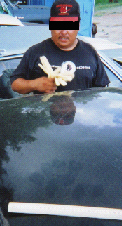 vehicle. Primate dermatoglyphics expert Jimmy Chilcutt examined the print in late June 2001. Despite his best efforts, Chilcutt was unable to lift any dermal ridge patterns. The heavy layer of dust and extremely hot temperatures made for the worst combination of conditions for documenting fingerprints. Nevertheless, features exhibited by the handprint may shed light on sasquatch hand structure.
vehicle. Primate dermatoglyphics expert Jimmy Chilcutt examined the print in late June 2001. Despite his best efforts, Chilcutt was unable to lift any dermal ridge patterns. The heavy layer of dust and extremely hot temperatures made for the worst combination of conditions for documenting fingerprints. Nevertheless, features exhibited by the handprint may shed light on sasquatch hand structure.
The second handprint discussed here (“Beta”) was discovered in September 2001. A team of investigators spent a few days in an extremely remote area where a number of sighting reports and track finds had surfaced. The public was unaware of the team’s presence and purpose. A black full-sized pickup, owned by one of the investigators, was left in an isolated spot on a logging road. Upon returning to the truck as the team prepared to depart for home, what appeared to be handprints and other disturbances were noted on the truck’s dusty surface.
The best print showed only fingertips and the partial thumb impression of a right hand (Fig. 2). Most of the associated markings were on the uppermost portions of the pickup’s bed and included hair patterns. However, the Beta print itself was just above the bottom edge of the bed, behind the rear wheel on the driver’s side, as if a sasquatch had crouched and steadied itself by placing its hand on the truck. A second comparable handprint, observed on the tailgate, showed fingers oriented toward the ground. This could indicate that the creature stood and turned after registering the Beta print and placed its left hand on the tailgate as it walked around the truck. It then appeared to move from the back toward the passenger side door, leaving noticeable hairstreaks as it did so. No claw marks were observed anywhere on the vehicle.
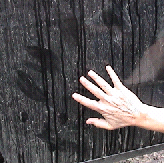 The Beta print was quite large. The field estimate of its span, based on an eight-inch investigator hand span (tip of thumb to tip of fifth finger), was fifteen inches. The 3.5-inch (across the knuckles) human hand accompanying the print in Figure 2 was held above the surface of the truck, making it appear slightly larger proportionately in the photo than it should be in comparison with the print. A direct comparison produces a hand span estimate of over fourteen inches, indicating that the initial fifteen –inch size estimate was fairly accurate. Two weeks after the discovery of the Beta print, another handprint was found a few miles away. Investigators judged it as a legitimate sasquatch handprint observation, but the quality of the photographic support makes it difficult to say much regarding its size (Fig. 3). It was found in association with a series of footprints traversing a very steep slope composed of loose material. The print dwarfs the hand (7.25 inches long) of one of the witnesses, but it does not appear to be as large as the Beta print.
The Beta print was quite large. The field estimate of its span, based on an eight-inch investigator hand span (tip of thumb to tip of fifth finger), was fifteen inches. The 3.5-inch (across the knuckles) human hand accompanying the print in Figure 2 was held above the surface of the truck, making it appear slightly larger proportionately in the photo than it should be in comparison with the print. A direct comparison produces a hand span estimate of over fourteen inches, indicating that the initial fifteen –inch size estimate was fairly accurate. Two weeks after the discovery of the Beta print, another handprint was found a few miles away. Investigators judged it as a legitimate sasquatch handprint observation, but the quality of the photographic support makes it difficult to say much regarding its size (Fig. 3). It was found in association with a series of footprints traversing a very steep slope composed of loose material. The print dwarfs the hand (7.25 inches long) of one of the witnesses, but it does not appear to be as large as the Beta print.
The next Oklahoma handprint (“Gamma”) was discovered in late October 2002 by a team of investigators, including three wildlife biologists, encamped in an area noted for footprints, vocalizations, and sightings. A muddy handprint was left on a white pickup during the predawn hours. Large muddy smudges and streaks were also found on the truck, beginning at the driver’s side of the tailgate and continuing to the passenger side of the cab. Distribution of the mud was primarily limited to the top and uppermost portions of the bed, the same pattern as was observed in association with the Beta print. No claw marks were noted; however, in some places the mud contained impressions that appeared to have been made by hair. Of the muddy marks, the only ones clearly indicative of having been created by a hand were found on the cab (Fig. 4).
Due to the deteriorating environmental conditions that existed the morning of the discovery, little could be done in the way of documentation.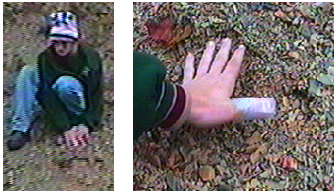 Measurements and drawings were made of the remaining traces in the following days to accompany measurements, sketches, and photos taken the morning of the discovery. Unfortunately, lighting conditions were such that the photos did not clearly show the marks.
Measurements and drawings were made of the remaining traces in the following days to accompany measurements, sketches, and photos taken the morning of the discovery. Unfortunately, lighting conditions were such that the photos did not clearly show the marks.
The cab of the pickup was 63 inches (1.6 m) high. The partial print of a left hand began seven inches from the edge of the seam separating the roof from the side panel of the extended cab, at the very back part of the roof (Fig. 4). The finger marks ran parallel to the back of the roof, over the rounded edge onto the side of the cab, and then parallel to the ground onto the side window towards the front of the vehicle, forming a 17.5 inch “swoop.” The bottom edge of the print on the window was about 57 inches above the ground. Over a dozen people observed it.
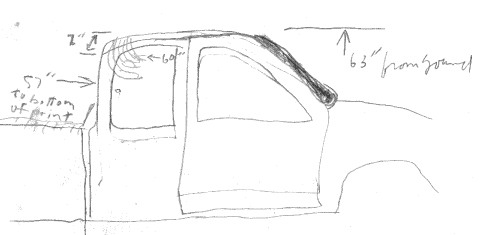
The length of the little (fifth) finger appeared comparable to the index and middle fingers. However, such a pattern could also be the result of an extended little finger and curled fingers two through four. The fifth finger stopped registering on the truck shortly after the roof/side curve started. The three remaining fingers continued together onto the side of the truck until the print ended. The distance between the fingers closed toward the termination of the print, ending with a combined width of just over three inches. The ends of the finger streaks indicated a very slight upward inflection. A rough sketch illustrates the general impression of the muddy streaks (Fig. 5). No hair marks were noted in association with the handprint.
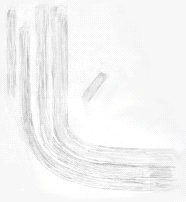 Intervals between finger marks (excluding thumb) on the roof varied only slightly. Assuming the marks reflected the breadth of the palm, outer measurements indicate a width for the narrowest part of the palm in the neighborhood of 130 mm, suggesting a size thirteen (XXXL) or larger hand (basketball legend Julius Irving has a size eleven hand). At its widest, the print measured 14.3 cm. Individual finger width marks on the roof were measured as follows: index, 33 mm; middle, 28 mm; “ring” finger, 22 mm; little finger, 20 mm. The mark registered by the thumb was 18 mm wide. Measurements made at several points of the three horizontal finger streaks were consistent at about 25 mm. Thus, the index finger displayed an apparent width reduction of twenty-five percent from beginning to end, whereas the fourth finger increased in its apparent width by about fourteen percent.
Intervals between finger marks (excluding thumb) on the roof varied only slightly. Assuming the marks reflected the breadth of the palm, outer measurements indicate a width for the narrowest part of the palm in the neighborhood of 130 mm, suggesting a size thirteen (XXXL) or larger hand (basketball legend Julius Irving has a size eleven hand). At its widest, the print measured 14.3 cm. Individual finger width marks on the roof were measured as follows: index, 33 mm; middle, 28 mm; “ring” finger, 22 mm; little finger, 20 mm. The mark registered by the thumb was 18 mm wide. Measurements made at several points of the three horizontal finger streaks were consistent at about 25 mm. Thus, the index finger displayed an apparent width reduction of twenty-five percent from beginning to end, whereas the fourth finger increased in its apparent width by about fourteen percent.
The distance from the tip of the index finger to the nearest edge of the thumb mark was 15.2 cm. The inner tip of the fifth (little) finger to the closest point of the thumb mark was 19 cm. The perpendicular width of the print from the outer edge of the thumb to the edge of the streak left by the fifth finger was 18.9 cm. These figures were used to reconstruct the print as it may have appeared prior to the initiation of the sliding movement (Fig. 6).
A few observations presented somewhat puzzling interpretation challenges. For example, no indication of a palm was noted in association with the Gamma print. By all appearances, the fingertips were drawn across the roof and onto the side of the truck in a smooth continuous motion, but the partial thumb mark indicated that it was not dragged. The hand evidently rested on the roof with the palm elevated (similar to the way some sprinters place their hands as they get ready to charge out of the starting blocks), then the thumb was lifted as the hand moved.
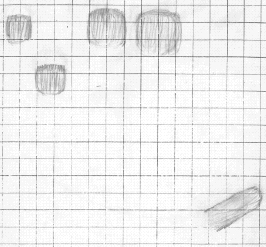 One problem with this idea is that the fourth or “ring” finger mark began about 40 mm short of the marks left by the other fingers (Figs. 5, 6). A possible explanation is that this finger was raised (as the other fingers were pressed on the roof) then lowered as the hand moved. However, that implies a rather awkward maneuver to execute. The fourth finger may have also been bent or curled under, or perhaps a portion of that finger was missing. However, fingers two through four appeared to have stopped registering on the vehicle at the same place; this outcome would seem unlikely with fingers of markedly unequal lengths.
One problem with this idea is that the fourth or “ring” finger mark began about 40 mm short of the marks left by the other fingers (Figs. 5, 6). A possible explanation is that this finger was raised (as the other fingers were pressed on the roof) then lowered as the hand moved. However, that implies a rather awkward maneuver to execute. The fourth finger may have also been bent or curled under, or perhaps a portion of that finger was missing. However, fingers two through four appeared to have stopped registering on the vehicle at the same place; this outcome would seem unlikely with fingers of markedly unequal lengths.
As noted, the Gamma print initially exhibited finger marks of varying widths. This contrasts with the broad fingers of rather equal widths seen in the Alpha handprint (Figs. 7, 8). Of course, the Gamma finger width measurements may have simply reflected the results of hand position and/or differential pressures. This possibility is supported by the observation of comparable finger widths approaching the terminus of the print.
[Note: The purported sasquatch fingerprints presented by Charles Hallmark, supposedly collected in the Chickasaw National Recreation Area in Sulphur, Oklahoma, are not considered to be genuine. Fingerprint expert Jimmy Chilcutt has determined that the prints in question are human in origin. Link to article about the “fingerprints.”]
Discussion
Krantz (1992) devotes several pages to an analysis of hand casts made by Marx and Freeman. Fahrenbach (2002) discusses another cast made by Freeman of a hand impression discovered in the late 1980s. Although the features noted by these scientists regarding the casts cannot be reviewed here in detail, their evaluations indicate a non-human origin.
Apparent or conjectured similarities between two-dimensional images, such as the Oklahoma handprints, and possible three-dimensional corollaries, as in the casts from Washington state, must be viewed with caution. It is probably safer to derive inferences from three-dimensional objects, such as casts, regarding potential signatures left on hard flat surfaces (e.g., fingerprints) than vice versa. As a crude example, the width of a human finger as seen in life or in a cast may be 15 mm, but the width registered on a chalkboard may only be 9 mm. In lieu of definitive references concerning sasquatch anatomy, it is only possible to speculate at a superficial level with regard to ostensive comparisons of different forms of evidence pertaining to sasquatch hand characteristics.

For example, sasquatch fingers appear to be quite stout. As revealed in prints and casts such as those shown in Figure 7, the fingers are broad in comparison with typical human finger widths. Unlike the elongated fingers of the great apes (Fig. 9), the Alpha print indicates relatively short and thick fingers, as does the Marx cast.
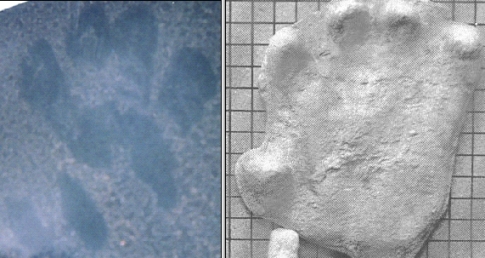
A closer look at a Marx cast and the Alpha print reveals other possible similarities (Fig. 8). Obviously, both are large in comparison with human hands, although the Marx cast is larger than the Alpha print, measuring about ten inches across the four fingers versus 7.5 inches. As can be seen in both pieces of evidence, the middle two fingers (digits three and four) appear to be similar in length, as are the index and little (5th) fingers. This is not the case with the human hand, where marked differences in length characterize those pairs of fingers (Figs. 9,10).
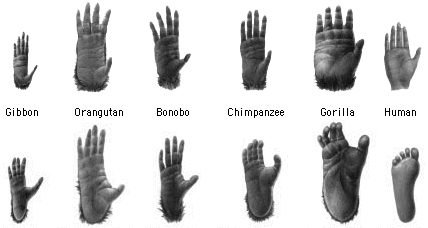
The Marx cast and the Alpha print both indicate an unusual (when compared to the human hand) placement of the thumb, an aspect noted by Fahrenbach (2002) in his article concerning sasquatch physical traits. The purported sasquatch thumbs shown in Figure 8 appear to be more proximally positioned than in humans. This could be the result of longer metacarpal bones, the absence of one or more thumb muscles found in humans, or a combination of both factors.
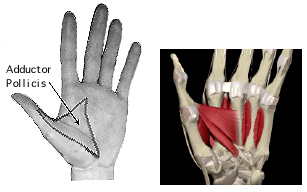 The human hand is considered to be comparatively unspecialized. The palm and fingers are both relatively short when compared with apes (Clarke 1999). From a palmar perspective, the ratio of the third finger to the palm approximates something like a 4:5 ratio. However, actual finger length in humans is typically comparable to or greater than the rest of the hand. This ratio is reversed in the great apes. In addition, contrasting with what is seen in humans, palm and fingers lengths in apes are closer in proportion to the ratios observed in the foot. Toe length is shorter than the remainder of the foot (tarsal and metatarsal bones) in the great apes, but not to the degree seen in the human foot (Fig. 9).
The human hand is considered to be comparatively unspecialized. The palm and fingers are both relatively short when compared with apes (Clarke 1999). From a palmar perspective, the ratio of the third finger to the palm approximates something like a 4:5 ratio. However, actual finger length in humans is typically comparable to or greater than the rest of the hand. This ratio is reversed in the great apes. In addition, contrasting with what is seen in humans, palm and fingers lengths in apes are closer in proportion to the ratios observed in the foot. Toe length is shorter than the remainder of the foot (tarsal and metatarsal bones) in the great apes, but not to the degree seen in the human foot (Fig. 9).
In any event, it is difficult to speculate much with regard to sasquatch phalange and metacarpal/carpal ratios. Estimates derived from images yield possible ratios close to 3:5, in other words, a longer palm than would be expected for humans. This could be a function of relatively longer second through fifth metacarpal bones, an apelike characteristic. The question needs to be addressed using source material instead of photographs.
Sasquatch thumb placement and hand appearance (Fig. 8), which looks to vary significantly from that of humans, could be a function of other anatomical factors besides bone structure. Thenar musculature, that is, the muscles constituting the ball of the thumb (or the thenar pad), is quite large in humans as compared with the great apes. The muscles making up this prominent group did not register in the Alpha print, and some of them appear to be absent or deficient in both the Marx and Foreman casts. For example, the opponens pollicis, comprising a large percentage of the human thenar pad, appears to be much reduced in the casts. It is unlikely that any normal human handprint could show as much palm surface as that demonstrated in the Alpha print and not leave a distinct impression of the ball of the thumb. This observation lends support the proposal that sasquatch thenar musculature differs from that of humans, as suggested by inspection of the Marx and Freeman casts (Figs. 8, 11,12) and discussed by Krantz and Fahrenbach. The combination of proportionately longer metacarpals and deficient opponens pollicis (which serves to bring the thumb into contact with the tip of the fifth finger) suggests limited opposability of the sasquatch thumb, at least as compared with the human hand.
Questions related to another component of thenar musculature, the adductor pollicis, are particularly intriguing. This muscle, with its origin on the second and third metacarpals, occupies half the width of the palm and most of the length of the metacarpals in the human hand. It takes up the webbed space between the first and second metacarpals (Fig. 10). The absence of this muscle, which serves, along with other muscles, to draw the thumb toward the hand, could alter hand morphology significantly along the lines of what is seen in the sasquatch hand evidence. Muscles such as the opponens pollicis and/or the flexor pollicis brevis presumably appropriate the role of the adductor pollicis if it is absent or deficient. These two muscles originate on wrist bones at the base of the index finger rather than spanning the gap between the first (thumb) metacarpal and the second metacarpal.
In spite of these apparent cast/print anatomical similarities, however, a palmar orientation of the sasquatch thumb, as proposed by Krantz in partial support of his contention that the sasquatch thumb is non-opposable, does not appear to be strongly supported by the Oklahoma evidence. Neither the Alpha print image nor the Gamma measurements, where the thumb width (18 mm) was the narrowest observed for that print, appear to indicate a thumb aligned in the same manner as the fingers. The dorsal and palmar surfaces of the thumb in all known primates are rotated or angled when compared to the rest of the hand, not facing in the same direction (Fig. 9).
One difference between the Marx cast (Fig. 8) and the Freeman cast (Fig. 11) concerns thumb placement; the 1986 Freeman cast appears to show a thumb placed farther forward than in the Marx cast. Krantz speculates that a combination of factors involving hand position and movement in the stratum could account for some of the apparent incongruity. Regardless of the source of variation, Krantz stated, “Among the least likely explanations would be that Freeman made an elaborate fake, with close attention to many fine anatomical details, yet failed to see this rather obvious discrepancy.” Another hand cast made by Freeman from an impression found near Walla Walla, WA (Fig. 12), does display a thumb whose attachment with the palm appears to be consistent with that indicated in the Alpha print and the Marx cast shown in Figure 8.
BFRO Curator Sue Lindley used the Walla Walla cast to construct a sasquatch hand model (Fahrenbach 2002). This model serves to further illustrate apparent differences between human and sasquatch thumb anatomy. In Figure 13, the human hands shown in a side-by-side comparison with the sasquatch model are enlarged so that palm lengths are similar. The leading edge of the human thumb is located midway on the palm. In contrast, the leading edge of the sasquatch thumb is located much closer to the wrist.
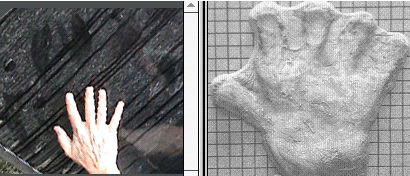 The human hand shown with the Beta print in Figure 11 measures 3.5 inches across the knuckles (size 9). The hand also shows the thumb positioned at the same angle as the thumb in the print. The Freeman cast thumb has a slightly larger angle when compared to the index finger than does the Beta print. The cast hand looks to be spread, as if the impression is a record of an individual catching itself during a fall. Assuming the grid shown with the cast has one-inch intervals, as stated by Krantz, the hand span measures about sixteen inches from the tip of the thumb to the outside edge of the little finger. Were the thumb from the Beta print shown at the same angle as that in the cast, the two hands would have produced quite comparable measurements, leading to the possibility that the creatures responsible for leaving the evidence were similar in size.
The human hand shown with the Beta print in Figure 11 measures 3.5 inches across the knuckles (size 9). The hand also shows the thumb positioned at the same angle as the thumb in the print. The Freeman cast thumb has a slightly larger angle when compared to the index finger than does the Beta print. The cast hand looks to be spread, as if the impression is a record of an individual catching itself during a fall. Assuming the grid shown with the cast has one-inch intervals, as stated by Krantz, the hand span measures about sixteen inches from the tip of the thumb to the outside edge of the little finger. Were the thumb from the Beta print shown at the same angle as that in the cast, the two hands would have produced quite comparable measurements, leading to the possibility that the creatures responsible for leaving the evidence were similar in size.
Another size similarity may exist with regard to the Gamma print and the cast shown in Figure 12. Finger diameters in the cast appear to be one inch or more, comparable to the diameters measured for the Gamma print fingers. The width of the palm in the cast, which appears to be about 5.5 inches, also compares favorably with the width surmised for the Gamma print (just over five inches). The Alpha print displayed an apparent palm width of about 4.3 inches. Estimating that something like fifteen to twenty percent of the actual hand width did not register on the surface (based on informal observations of human prints), and adjusting the measurement by an intermediate factor (4.3/0.825), produces a palm width approximation of 5.2 inches for the Alpha print. These hand sizes correspond to human size equivalents of 13 to 14 (XXXXL). Hand size is determined via a circumferential measure at the knuckles. In humans this distance in inches corresponds to width in centimeters, that is, a nine-inch circumference would correspond to a nine cm width and a size nine hand. Extra hand thickness in the form of a 2 cm thick pad on the palm, as proposed by Krantz, would produce even larger hand sizes.
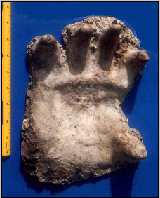 Hand posture and movement inferences related to the formation of the Gamma print (e.g., raised palm, lifting of thumb) lend themselves to speculation regarding standing height. A human source has been ruled out. However, even if this print was the result of a hoax or other human activity, the evidence suggests an elbow height of five feet or more. This is based on the observation that horizontal surfaces located at or below the elbow upon which an extended hand rests may show only the tips of fingers, whereas such surfaces above the level of the elbow should be expected to produce contact with the palm. An elbow located at five feet above the ground, multiplied by a factor of 1.6 (conservative even for humans having, theoretically, relatively shorter arms than sasquatches), produces a height estimate of eight feet.
Hand posture and movement inferences related to the formation of the Gamma print (e.g., raised palm, lifting of thumb) lend themselves to speculation regarding standing height. A human source has been ruled out. However, even if this print was the result of a hoax or other human activity, the evidence suggests an elbow height of five feet or more. This is based on the observation that horizontal surfaces located at or below the elbow upon which an extended hand rests may show only the tips of fingers, whereas such surfaces above the level of the elbow should be expected to produce contact with the palm. An elbow located at five feet above the ground, multiplied by a factor of 1.6 (conservative even for humans having, theoretically, relatively shorter arms than sasquatches), produces a height estimate of eight feet.
Sources for the Oklahoma prints (and, for that matter, the Washington state casts) are either human or non-human. Presupposing a non-human origin, the black bear would appear to be the only logical candidate, however unlikely that may be, other than the sasquatch. In the case of the Alpha print, dimensions and geographic location both serve to exclude bears as an option.
The Beta and Gamma prints were associated with distinct hair markings observed running along the tops of pickup beds. One would typically predict that a black bear circling a truck would do so on all fours and that contact would show on the sides and lower portions of the vehicle. Instead, hair flow marks paralleled the truck beds, that is, the evidence indicated that an animal walked along the side of the vehicles rather than standing next to them.
Other factors would also seem to preclude a bear explanation for the Beta and Gamma prints. For example, one should expect to observe black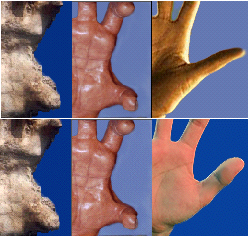 bear claw marks where evidence suggests that an animal reached. As noted earlier, no claw marks were present on either vehicle affiliated with those prints. Also, five toes should have registered simultaneously instead of four toes/fingers and a thumb. Nevertheless, it is theoretically possible that bear claw and toe marks could have simply not registered. Although the size of the Beta print was well outside the range for black bears, the Gamma print width was at the upper extreme described by Rezendes (1999). However, the Gamma print pattern (Fig. 5) would not appear to be possible for a bear to duplicate. If a bear produced the print, toe widths would indicate that a right foot made it and that the inner toe simply didn’t register. The thumb mark would have to be discounted. Executing the 90-degree turn shown in the Gamma print would have been a simple matter for a primate, but the wrist/elbow/shoulder and side stepping actions implied by the marks appear to be beyond expected carnivore musculoskeletal mechanics.
bear claw marks where evidence suggests that an animal reached. As noted earlier, no claw marks were present on either vehicle affiliated with those prints. Also, five toes should have registered simultaneously instead of four toes/fingers and a thumb. Nevertheless, it is theoretically possible that bear claw and toe marks could have simply not registered. Although the size of the Beta print was well outside the range for black bears, the Gamma print width was at the upper extreme described by Rezendes (1999). However, the Gamma print pattern (Fig. 5) would not appear to be possible for a bear to duplicate. If a bear produced the print, toe widths would indicate that a right foot made it and that the inner toe simply didn’t register. The thumb mark would have to be discounted. Executing the 90-degree turn shown in the Gamma print would have been a simple matter for a primate, but the wrist/elbow/shoulder and side stepping actions implied by the marks appear to be beyond expected carnivore musculoskeletal mechanics.
Conclusions
Several possible sasquatch handprints were documented in Oklahoma. The prints did not appear to be artificially manufactured. They exhibited comparable characteristics with casts of hand impressions made in the Pacific Northwest. Insofar as these similarities exist, the contemporary prints provide a degree of support for the validity of the casts, made decades earlier.
Perhaps the information and comparisons presented here may serve to facilitate an increased understanding of sasquatch biology, especially by those with backgrounds in primate anatomy, and prompt further study of the Washington casts. Field investigators should be encouraged in their awareness of sasquatch handprints as a potential area of research and evidence collection.
Acknowledgements
Roger Roberts and Brett Elliott were instrumental in the collection of the handprint evidence from Oklahoma. W. H. Fahrenbach, Richard Noll, and Jeff Meldrum offered helpful input and suggestions.
References
Clarke, R. J. 1999. Discovery of complete arm and hand of the 3.3 million-year-old Australopithecus skeleton from Sterkfontein. S. Afr. J. Sci. 95(11): 477-480.
Fahrenbach, W. H. 2002. Anatomy. In What is a Bigfoot, or Sasquatch?
Glickman, J. 1998. Toward a Resolution of the Bigfoot Phenomenon. Photec Research Report. North American Science Institute
Krantz, G. S. 1992. Big Footprints: A Scientific Inquiry Into the Reality of Sasquatch. Johnson Printing Co., Boulder, CO.
Linden, E. 1992. A Curious Kinship: Apes and Humans. National Geographic. 181(3): 2-45.
Rezendes, P. 1999. Tracking and the Art of Seeing: How to Read Animal Tracks and Sign (2nd ed.). HarperCollings Publishers, Inc., NY.
Stein, T. 2003. Bigfoot believers: Legitimate scientific study of legend gains backing of top primate experts. The Sunday Denver Post. Jan. 5, 2003, p. 1A, 18-19A.
Revision History
This paper was written in the spring of 2003 and originally published as an internal document for the Bigfoot Field Researchers Organization. It was presented at the 2004 Texas Bigfoot Conference and is republished here by permission of the author. It was slightly revised and expanded December 31, 2005.
